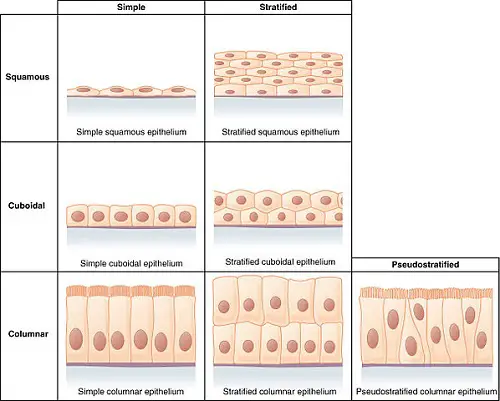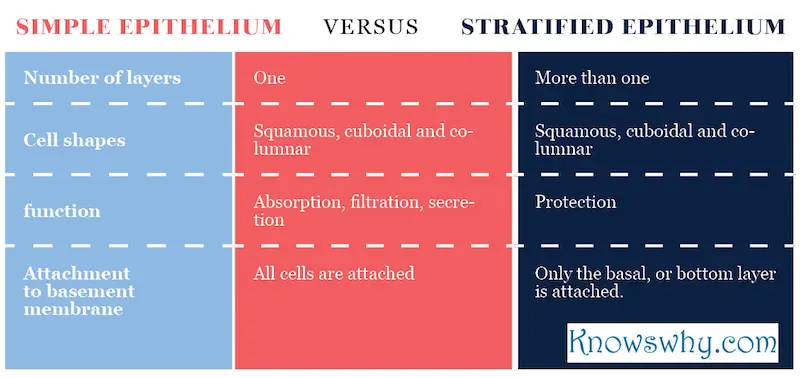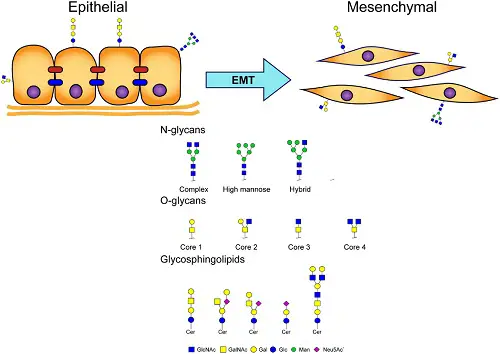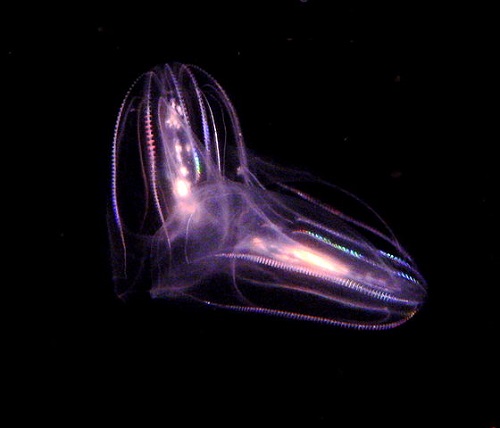
Epithelial tissue is one of the four major tissues of the body: epithelial, connective, muscle and nervous tissue. Epithelial tissue lines and covers internal and external surfaces of the organs and the body.
All glands are made of epithelial tissue. There are two types of glands: exocrine and endocrine.
Endocrine glands secrete into the extracellular space and their secretions are taken up by blood vessels.
Exocrine glands secrete through a duct that leads to an organ or onto the epithelial surface.
There are two categories for the number of layers of cells of epithelial tissue. Simple epithelium is one single layer attached to a basement membrane, while stratified epithelium is multiple layers with only the deepest layer attached to the basement membrane.
Similarities:
All epithelial tissue rests on a basement membrane.
Simple and stratified epithelial tissue cells can classified as squamous, cuboidal or columnar, by shape.
Epithelial tissue covers or lines other tissues. One surface is attached to a basement membrane. The other, apical surface, is a free surface exposed to air, as in skin, or body lumens, such as the lining of the digestive and respiratory tracts, surfaces of organs and lumens of blood vessels.
Epithelial tissues contain no blood vessels, so they receive all their nutrition through diffusion from connective tissue underlying the basement membrane.
Epithelial tissues have cell junctions that hold the cells together. Since they cover and line other tissues and organs, it is imperative that they prevent movement of substances through spaces between the cells. Cells are tightly packed with no intercellular space.
Differences:
The difference between simple and stratified epithelium is the number of layers of cells. Simple has one layer and stratified has more than one layer.
Pseudostratified epithelial tissue is classified as simple because all cells attach to the basement membrane, even though not all cells reach the apical surface.
Simple epithelial tissue functions in absorption, secretion and filtration, while stratified epithelial tissue functions in protection.
Stratified squamous epithelial tissue can be keratinized, or non-keratinized. Keratinized cells are filled with the protein keratin and are actually dead. The surface of skin is keratinized. Non keratinized stratified squamous cells are not filled with keratin. They are alive and contain nuclei. The inside lining of the mouth is non keratinized stratified squamous epithelial tissue.
Simple epithelial tissue:
There are four types of simple epithelial tissue. Three types are differentiated by cell shape.
- Simple squamous epithelial tissue cells look like they are squashed. They look like a fried egg with the nucleus slightly raised in the center. They are thin and look like fish scales. Filtration occurs only through the simple squamous cells of the glomerulus in the kidney.
- Simple cuboidal epithelial tissue cells look like cubes, or squares.
- Simple columnar epithelial tissue cells look like columns. They usually have microvilli to increase the surface for absorption. Simple columnar epithelial tissue lining the digestive lumen contains goblet cells which secrete mucus to aid in the movement of food through the digestive tract.
- Pseudostratified epithelial tissue looks like it is stratified, because not all cells reach the apical or top surface. All cells are attached to the basement membrane. The cells are ciliated.
Simple epithelial tissue functions in absorption, secretion and filtration.
Stratified epithelial tissue:
There are four types of stratified epithelial tissue, three of which are differentiated by cell shape. The shape of the cell is identified at the apical, or top surface. The fourth type is transitional epithelial tissue. The shape of the cells changes due to environmental changes.
- Stratified squamous epithelial tissue cells are layers of squamous cells. Skin is an example.
- Stratified cuboidal epithelial tissue cells are layers of square shaped cells.
- Stratified columnar epithelial tissue cells are layers of column shaped cells.
- Transitional epithelial tissue changes shape. It lines the urinary bladder. When the bladder is empty, the cells appear cuboidal. When the bladder is full, the cells slide over each over and appear squamous.
Stratified epithelial cells function in protection because there are many layers of cells.
Skin is stratified squamous epithelial tissue. Stratified epithelium resists abrasion.
Only the cells attached to the basement membrane reproduce. As they divide, one cell moves up and the other remains to divide again.
Locations and function of epithelial tissue types
Epithelial tissue type |
Location |
Function |
| Simple squamous | Lining blood vessels, alveoli, pericardium | Diffusion |
| Simple cuboidal | Kidney tubules, pancreas, glands | Secretion, absorption |
| Simple columnar | Stomach, small intestine | Secretion, absorption |
| Pseudostratified | Trachea, airways, nose | Cilia move mucus |
| Stratified squamous | Lines esophagus, mouth | Protection, water proof |
| Stratified cuboidal | Sweat glands, mammary glands | Protection |
| Stratified columnar | Male urethra | Secretion |
| Keratinized stratified squamous | Skin | Protection |
| Transitional | Urinary bladder | Capable of stretching |
Summary
Simple epithelial tissue is one layer of cells attached to a basement membrane.
Stratified epithelial tissue is more than one layer of cells. Only the basal layer is attached to the basement membrane. Only the basal layer is capable of reproduction.
Simple and stratified epithelial cells can be squamous, cuboidal or columnar.
Stratified epithelial cells can be transitional, or change shape from cuboidal to squamous.
Stratified squamous epithelial cells can be keratinized, or dead cells without nuclei, filled with the protein, keratin, or non-keratinized, live cells containing nuclei.
Epithelial tissue lines body cavities, organs or covers organs.
The major function of simple epithelial tissue is secretion, absorption and filtration.
The major function of stratified epithelial tissue is protection against dehydration and abrasion.
Simple epithelium versus stratified epithelium













Leave a Reply